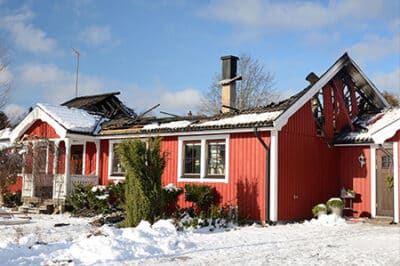Many people see dwelling coverage as the same thing as homeowners insurance but truth is, it’s not. Dwelling coverage is simply one portion of your home insurance package, and arguably the most pivotal. Generally, it covers only the home itself and not the contents installed in it or land. In this article, you will get to know everything about what dwelling coverage is for homeowners or home insurance, for a condo, its limit as well as coverage amount.
Let’s get started…
Dwelling Coverage
Dwelling coverage refers to the coverage included in your basic HO3 (homeowners’ policy) that protects your home. This coverage covers your primary residence as well as any related structures against the risks outlined in your policy. Covered perils include damage from fire, smoke, lightning, hail, falling objects, vandalism, robbery, windstorms, and other natural disasters.
It covers damage to the physical structure of the policyholder’s home that has defined risk. However, the appropriate level of coverage varies from person to person and is, at the same time, determined by personal needs. Likewise, the cost of rebuilding your home determines how much dwelling coverage you require.
In addition, your homeowner’s insurance may assist pay the expenses of repairing or rebuilding your house if you file a claim for damage caused by any of the outlined dangers. Dwelling coverage also covers all attached structures, such as a garage or porch, as well as built-in appliances, if they suffer damages together with your house.
What Does Dwelling Mean?
Simply put, your dwelling is the home or building you live in. Defining a dwelling under a home’s insurance policy includes all structures linked to your home, including the garage, fence, or deck. At the same time, as built-in appliances like a furnace or water heater, Garages, sheds, and other similar structures are also needed to be part of your home.
However, if you are in a situation whereby you own a condo, make sure you get a complete list of what you need to insure and submit it when purchasing homeowners’ insurance. Likewise, parts of your condo are shared with other owners if you own a condo. So look over your condominium association’s master insurance policy to see which portions get coverage by the master policy.
How Much Dwelling Coverage Do You Need?
In most cases, dwelling coverage limits should be sufficient to allow you to reconstruct your house or condo to its previous condition prior to being consequent by an outlined risk. So, you don’t want to choose the purchase price or current market value when determining the amount of Dwelling coverage for your property. Generally, this is the cost of rebuilding your home (the way it use to be before the need for it to be rebuilt; no changes). Another name for it is “reconstruction costs.”
After all, this is what your insurance provider will reimburse you for if you have to rebuild in the worst-case situation. However, there are also all of the other coverages to consider (Personal Liability, Loss of Use, and so on).
What Dwelling Coverage Protects in Your Home
All structural parts, as well as any structure considered “to have a connection to the home, are covered under dwelling coverage. Among them are:
- Foundation
- Frame, flooring, and windows
- Roofing
- Fireplace chimneys
- Plumbing, electrical, and HVAC systems
- Built-in fixtures (cabinetry, bathroom sinks, tubs, showers, etc.)
- Built-in appliances (water heater, furnace, water filtration system, etc.)
- Attached garage
- Front or side porches
- Back deck
- In-ground swimming pool
What Dwelling Coverage Does Not Cover?
Though, in most cases. other elements of your homeowner’s insurance policy, such as personal property coverage, may cover these items, housing insurance does not:
- Garage with a separate entrance
- A swimming pool that is above ground
- Fencing
- Trampolines or playsets
- Tiny houses or tool sheds
- Treehouses
Hazards that Dwelling Coverage Does Not Cover
In most cases, homeowner’s insurance does not cover damage caused by:
- Inadequate maintenance damage
- Floods
- Earthquakes
- Sewer backup/Sump pump coverage.
However, extra coverage for floods, earthquakes, and water backups may be available. You should, however, check your policy to determine what is covered.
What Is Dwelling Coverage for Condo?
Generally, condo dwelling coverage is part of a larger condo insurance policy, and it differs from homeowners insurance in terms of cost, coverage, and other factors.
In terms of cost, coverage, and other factors, condo dwelling insurance differs from homeowners insurance on a house. Condo owners’ dwelling coverage only covers the cost of replacing the structure and contents of their condo. Meanwhile, if you reside in a condo, your HOA insurance requirements, which usually include dwelling coverage, will be expected of you.
Check with your condo organization to verify whether any of the below coverage categories are applicable to its master policy before purchasing condo insurance. And depending on the HOA’s master policy, there may be the need for you to insure the interior of your condo with dwelling coverage. Alternatively, it might be best to buy the all-inclusive coverage.
#1. All-inclusive or all-in
This option covers any components built into your units, such as light fixtures, appliances, and cabinetry. It also covers any upgrades you make to these elements, under your organization’s master policy. Typically, there is no need for you to include dwelling coverage on your condo policy when your HOA already provides all-inclusive coverage.
#2. Coverage for a single entity
Single entity coverage is similar to all-in coverage. The only difference is, it excludes any modifications or additions you make to your condo, leaving only the original fixtures and appliances covered. On this note, you may wish to add building property coverage to your policy if you make significant improvements to your unit. Nevertheless, you’ll have to check your condo policy for coverage for these items.
#3. Coverage of bare walls
The unit’s walls, floors, and ceilings, but not the carpets, light fixtures, appliances, or sinks that are linked to them. You will need to cover all these pieces of equipment under your personal condo coverage. However, if your condominium association’s homeowner’s association (HOA) has a bare walls master policy, you can assure your four walls are already under protection by the HOA’s insurance policy.
Dwelling coverage, just like personal property coverage, usually only covers disasters that are explicitly outlined in the policy, like theft and fire.
Dwelling Coverage for Homeowners Insurance
A typical homeowners insurance policy is designated to safeguard your home, however, it is typically divided into multiple categories. Among these categories is dwelling coverage. So, when purchasing a home insurance policy, make sure you get enough coverage to safeguard all of your assets in the event your home is destroyed in a disaster,
On a normal basis, homeowners’ insurance coverage covers four major areas:
#1. Dwelling coverage; designed to help you rebuild your house.
#2. Personal property coverage; This is employed to replace items that have been lost due to covered danger.
#3. Liability insurance; this one that protects you in the event that someone d on your property and file a claim against you.
#4. Additional living expenses (ALE) coverage; covers your costs of living in a hotel, meal expenses, and more while your home is being attended to after a perilous loss. You can consider purchasing additional homeowners insurance if you notice your present policy’s limits aren’t enough to cover these costs.
Dwelling coverage however is a portion of your homeowners’ insurance policy. One that helps pay to rebuild or repair the physical structure of your home in the event of an outlined loss.
Dwelling Coverage in Home Insurance
Considers home insurance to be a protective package. Generally, in a home insurance policy, dwelling coverage is designated as “Coverage A.” And it only covers the building of the house, not the items or the land. However, consider getting replacement cost coverage when it comes to insuring your home. If your house burned down, the cost may be more than its current market value.
Other Coverages Depending on Your Dwelling Coverage
Personal Property coverage
When pricing out your personal things, most experts advise setting a limit of 50 to 75 percent of your total dwelling coverage. However, you should look into the Extra Coverage option with your insurer if you have arts or a lot of pricey jewelry. Thus, extra coverage also provides greater coverage in general, therefore it’s something worth considering.
Loss of Use Coverage
Additional expenses, commonly known as Loss of Use, are calculated using Dwelling coverage. Most experts recommend a sum equal to 20-30% of your Dwelling insurance. Also, if you order takeout for breakfast, lunch, and supper every day, you’ll probably want to order a greater quantity than someone who shops for groceries and prepares their own meals. Take into account your lifestyle as well, as this covers things like food, temporary storage, moving expenses, and so on.
What is Dwelling Coverage Limit
The dwelling limit is generally the highest limit in your homeowners’ insurance policy. It pays to rebuild or repair your home in the event of damages caused by perilous risks. However, the dwelling coverage limit is the most your homeowner’s insurance company will pay to reconstruct your home.
In the meantime, you should have adequate dwelling coverage to pay for the rebuilding of your home and any associated structures. Keep in mind that built-in appliances, such as a water heater, must have a replacement. The cost of replacing your home is determined by a number of criteria, including the amount it would cost to rebuild at current construction and labor costs;
- The cost of construction and labor in your area
- Your home’s square footage
- Any custom-built features
- Number of rooms
- Architectural style
- Age of home
- Number of stories
- The style of the house (such as a ranch or colonial home)
Your policy limit is automatically enhanced if your house is damaged or destroyed and the rebuild costs exceed the dwelling coverage limit in your policy. Although this coverage comes at a premium, the benefits it provides make it a worthy investment. Also, bare it in mind that building and labor prices are subject to change, particularly following a natural disaster.
An insurance appraisal is a useful technique to determine how much dwelling coverage you require and the limit. You can hire an independent appraiser or have your insurance company send their own appraiser to analyze your home. However, call your own appraisal over if you believe your insurance company’s estimate is excessively expensive or low. It can be worth the effort.
What is Dwelling Coverage Amount?
Generally, the amount of dwelling coverage you have in your insurance has a big impact on your premium. For instance, an apartment with a $250,000 insurance limit costs 37% more to insure than the one with a $150,000 limit. While the one with a limit of $350,000 is 75% higher.
Showing below is the difference in the price of home insurance premiums by dwelling coverage amount.
| Dwelling coverage | Monthly cost | Annual cost |
| $150,000 | $175 | $2,096 |
| $250,000 | $239 | $2,862 |
| $350,000 | $306 | $3,672 |
However, if you’re underinsured, you’ll get less money when you file a claim. The 80/20 rule describes this circumstance. And regardless, the majority of homeowners insurance companies require you to insure your home for at least 80% of its replacement value. In this case, you will receive $67,000 less your deductible, and be responsible for the remainder of the repairs.
Dwelling Coverage FAQs
How do you calculate dwelling coverage?
For a rough estimate of your dwelling coverage amount, you can simply multiply the square footage of the home by the local rebuild cost per square foot.
What is the difference between homeowners and dwelling?
There is a major difference between the two types of coverage that can help you understand. A dwelling policy covers only the physical structure of the home. A homeowners insurance policy is more comprehensive and covers not only the physical structure but also the contents inside the home
What is covered under loss of use?
Loss of Use coverage only applies when your home becomes uninhabitable resulting from a covered loss. This coverage covers any Additional Living Expense, meaning any necessary expense that exceeds your normal standard of living.
What is the 80% rule in insurance?
The 80% rule means that an insurer will only fully cover the cost of damage to a house if the owner has purchased insurance coverage equal to at least 80% of the house’s total replacement value.
Related Articles
- CONDO: Definition and Comparison of Condominium With Other Housing Types
- FHA APPROVED CONDO: The updated list & How to get one (+ free tips)
- AVERAGE HOME INSURANCE COST: Best 2023 UK Practices and Rates (Updated)
- SHELTER INSURANCE: 2023 Reviews, Rates, and Coverages
- BEAR RIVER INSURANCE UTAH: Auto & Home Insurance Reviews






